How to Make Tebamoto-ni (手羽元煮) – Japanese Soy-Braised Chicken Drumettes with Eggs
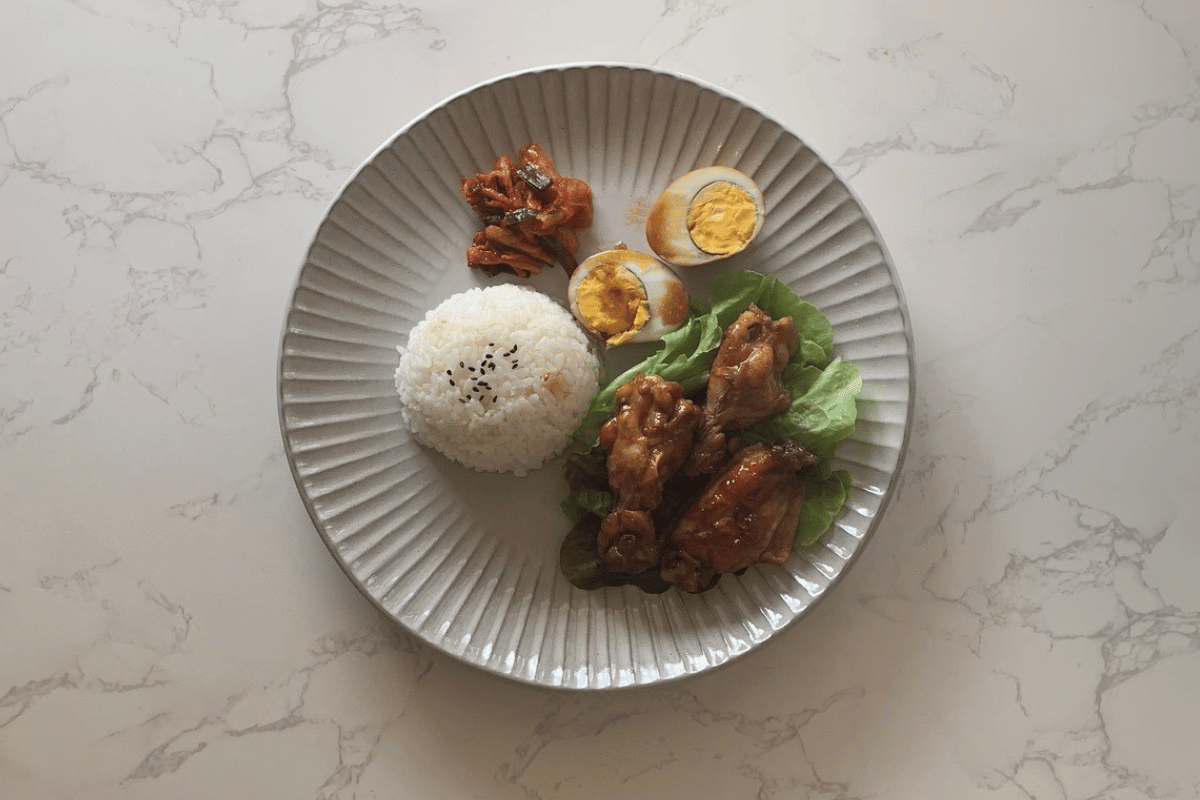
A Cozy Japanese Stew, Straight from Home
This Tebamoto-ni recipe is a comforting Japanese dish made with chicken drumettes simmered in a sweet-savory soy broth. It’s one of my favorite easy home-style stews — full of umami and perfect with rice. 🍳✨
This is true Japanese home cooking — a simple, satisfying stew that’s often made in large batches and gets better with time. Whether you’re serving it over rice or packing it into a bento, it delivers big flavor with very little fuss.
This Tebamoto-ni recipe is perfect for those who want a cozy, home-style Japanese dish that’s both simple and deeply flavorful.
I often make this Tebamoto-ni recipe ahead of time — it tastes even better the next day once the flavors have deepened.
This Tebamoto-ni recipe is one of my favorite cozy Japanese dishes — a soy-braised chicken and egg stew that’s perfect over a bowl of rice. It’s the kind of warm, home-style meal I grew up eating in Japan.
If you love comforting Japanese flavors, you might also enjoy my Agedashi Tofu or Tofu Chicken Hambagu — both simple and full of umami.
Today, I’m sharing a version of Tebamoto-ni that’s easy to make, deeply flavorful, and perfect for beginners too. Let’s get cooking!
🛒 Ingredients
- 8–10 chicken drumettes or wingettes
- 4 boiled eggs, peeled
- 1 tablesoppn sugar
- 4 tablespoons soy sauce
- 2 tablespoons mirin
- 2 tablespoons sake
- 100ml water or dashi stock
- 1 tablespoon Chinese black vinegar (or balsamic vinegar)
- 1 small piece of ginger, thinly sliced
- Optional: green onions or shichimi togarashi for garnish
🍲 Instructions
- Boil the eggs in advance, peel, and set aside
- Heat a bit of oil in a large pot over medium heat. Add the chicken drumettes and cook until lightly golden on all sides.
- Pour in the sake and let it simmer for a minute or so to allow the alcohol to evaporate.
- Stir in the mirin, sugar, and then the soy sauce, along with the sliced ginger. Add water or dashi and bring to a gentle boil.
- Simmer the stew and Add the boiled eggs:
- Reduce the heat to a simmer and skim off any foam. Let it cook for 25 minutes.
- Add about 1 tablespoon of Chinese black vinegar to enhance umami. If unavailable, balsamic vinegar works beautifully too.
- Serve warm over rice. Garnish with sliced green onions or shichimi togarashi if desired. It tastes even better the next day!
🍳 Tips & Variations
- Use dashi instead of water for extra umami depth.
- This dish pairs beautifully with steamed rice and a side of miso soup.
- Want extra color? Add a small splash of dark soy sauce at the end.
- You can also simmer daikon or carrots in the pot if you’d like more veg.
🌸 Why You’ll Love This Recipe
- It’s a one-pot dish — minimal cleanup!
- Uses affordable ingredients you might already have
- Feels homey, comforting, and deeply satisfying
- Easy to scale up and great for meal prep or lunchboxes
🇯🇵 What Does “Tebamoto-ni” Mean?
“Tebamoto” refers to the upper part of a chicken wing (drumette), and “ni” (煮) means to simmer or stew. This is a classic Japanese technique for cooking proteins gently in a seasoned broth.
It’s the kind of dish you’ll find in Japanese kitchens everywhere — from obento lunches to weeknight dinners.
🥚 A Note About the Eggs
If you love ajitama-style ramen eggs, you’ll love the eggs in this stew.
They soak up the soy sauce and become rich, savory, and just slightly sweet.
For extra flavor, let the whole dish cool and reheat it the next day — the eggs become even more flavorful!
🧡 Final Thoughts
Tebamoto-ni is everything I love about Japanese cooking — simple, soulful, and packed with flavor.
It reminds me of warm family dinners and quiet kitchen moments.
I hope you give it a try — and fall in love with its quiet magic too.
🥢 Extra Tip: Add a Splash of Vinegar for Extra Umami
I like to finish this dish with about 1 tablespoon of Chinese black vinegar. It adds a beautiful depth and gentle acidity that balances the sweetness of the broth — and gives the stew a little extra “umph.”
If you don’t have black vinegar, balsamic vinegar works surprisingly well! It has a similar sweetness and mild tang that pairs perfectly with soy sauce.
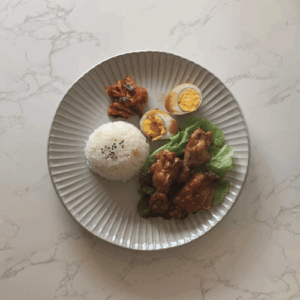
Tebamoto-ni (手羽元煮) – Japanese Soy-Braised Chicken Drumettes with Eggs
Ingredients
- 8 to 10 drumettes or wingettes or both
- 4 boiled eggs, peeled
- 1 tbsp oil (for browning)
- 4 tbsp soy sauce
- 2 tbsp mirin
- 2 tbsp sake
- 2 tsp sugar
- 100 ml water or dashi
- 1 tbsp Chinese black vinegar
- 1 small piece of ginger, thinly sliced
- Optional: sliced green onion or shichimi togarashi for garnish
Instructions
- Boil the eggs in advance, peel, and set aside.

- Heat oil in a pot over medium heat. Add the chicken drumettes and cook until lightly golden on all sides.

- Pour in the sake and let it simmer for about a minute to allow the alcohol to cook off.
- Add the peeled boiled eggs.
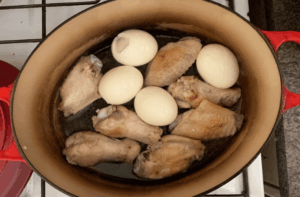
- Add mirin, sugar, soy sauce, sliced ginger, and water (or dashi). Stir to combine.
- Bring to a boil, then reduce to a simmer. Skim off any foam that rises to the surface.
- Continue simmering for 25 minutes, turning occasionally, until the chicken is tender and the broth has slightly reduced.
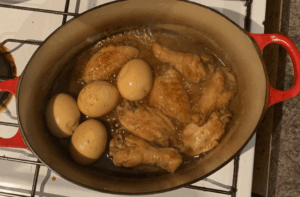
- Add black vinegar and stir to finish.
- Serve warm over rice. Garnish with green onions or shichimi if desired. Enjoy!
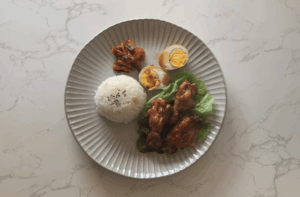
Notes
💡 Recipe Notes (optional section):
- Balsamic vinegar can be used instead of Chinese black vinegar if unavailable — it adds a similar sweet-acidic balance.
- The dish tastes even better the next day after the flavors have deepened.
- You can also add daikon or carrots to the stew if you want extra vegetables.
